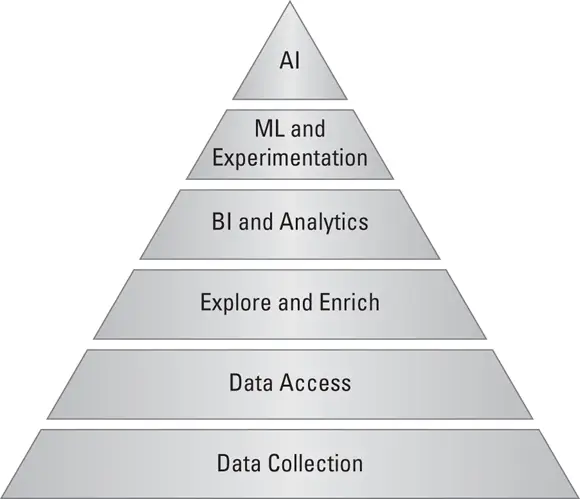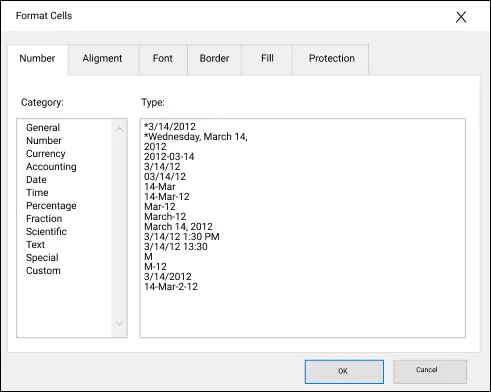
FIGURE 3-4:Relationship: Call center wait time versus satisfaction score.
Of the three pillars of AI — processing power, scalable storage, and big data — the third is the one that presents the biggest challenge. How to get it, how to validate it, how to process it.
Figure 3-5 shows the pyramid of critical success factors for AI and analytics. Four of the six layers relate to data, focusing on relevance, accessibility, usability, completeness, and data-based conclusions.

FIGURE 3-5:Pyramid of critical success factors for AI and analytics.
Table 3-2describes critical questions to answer at each layer.
TABLE 3-2Pyramid of Critical Success Factors for AI and Analytics
| Element |
Questions |
| AI |
How will you address analytical deployment, governance, and operations? |
| Experimentation ML |
Does machine learning add business value? How do you define success? |
| BI / Analytics |
What is the story your data is telling? What conclusions can you make from this information? |
| Explore and Enrich |
Can the data be used meaningfully? Are you missing any data or features? |
| Data Access |
Is the data accessible and usable (analysis-ready)? Is the data flow reliable? |
| Data Collection |
Do you have data relevant to your business goals? |
Before you start, you should perform a data audit to determine what data you already have and identify gaps in your data that you must fill to accomplish your business goals.
As mentioned in Chapter 1, for the enterprise, data falls into two categories: structured data (databases and spreadsheets) and unstructured data (email, text messages, voice mail, social media, connected sensors, and so on). Potential sources for data include:
Internal data: The first place to look is the IT department, but depending on the organization, you may not find everything you need in one place. The most common challenges associated with big data aren’t analytics problems; they are information integration problems. To reap the benefits of big data, you must first slay the data silo dragon, from department-level tribal thinking down to that one app on that one computer in that one person’s office.
Data capture: The second place to look is the data entering your organization. It can arrive in many forms, but you can use data extraction, metadata extraction, and categorization to supplement data. For example, you can run paper documents, whether handwritten or printed, through an optical character recognition system to digitize them in preparation for processing. Then they can join the rest of the digital data, such as emails, PDF files, Word documents, images, voice mail messages, videos, and other formats to be classified and populate the data store that will feed your AI insights.
Data as a service (DaaS): If there are still holes in your data requirements, you can turn to third-party data for purchase, either commercial datasets such as Accuweather or public datasets such as data.gov and Kaggle.com. Broadening your datasets can increase the insights lurking in your own data.
What’s worse than no data? Dirty data. Dirty data is poorly structured, poorly formatted, inaccurate, or incomplete.
For example, you might expect it would be easy for a system to scan a document and extract a date — until you reflect that Microsoft Excel alone has 17 different date formats, as show in in Figure 3-6.
Table 3-3shows several ways that dirty data can manifest.

FIGURE 3-6:Microsoft Excel supports 17 date formats.
TABLE 3-3Types of Dirty Data
| Type |
Example |
| Incomplete |
Empty or null values — the most prevalent type of bad data |
| Incorrect |
A date with a 47 in the month or day position |
| Inaccurate |
A data with a valid month value (1-12) but the wrong month |
| Inconsistent |
Different formats or terms for the same meaning |
| Duplicate |
One or more occurrences of the same record |
| Rule violation |
Starting date falls after ending date |
 Why is dirty data worse? Because it costs you more.
Why is dirty data worse? Because it costs you more.
For most companies, bad data costs from 15 to 25 percent of revenue as workers research a valid source, correct errors, and deal with the complications that result from relying on bad data.
The solution is to focus on data, not models. Not surprisingly, in a recent CrowdFlower survey, data scientists said the top two time-consuming tasks were cleaning and organizing data (60 percent) and collecting datasets (19 percent). However, in the survey, they also identified as the least enjoyable part of their job cleaning and organizing data (57 percent) and collecting datasets (21 percent).
Here’s a particularly trenchant example of the importance of data quality. In 2015, the International Classification of Diseases, Ninth Revision (ICD-9) coding system used for medical claims was replaced by the more robust, more specific ICD-10 system. ICD-10 provides a higher level of specificity that includes diagnoses, symptoms, site, severity, and treatments. Health providers had the option to use the simpler unspecified ICD-9 codes during the first year as they learned and became accustomed to the more complex system.
During the one-year grace period, many providers just continued to use the ICD-9 codes rather than transition to the more accurate ICD-10 codes, and their automated claims submissions reflected the less specific data. Claim denials increased, which meant more work for the providers who had to retroactively collect supporting documentation to appeal the denial or face loss of revenue. If they had submitted the claims with the more accurate, although a bit more complex, ICD-10 codes, the extra work wouldn’t have been necessary.
You can take this anecdote a step further. Imagine that a few years later, the facility that didn’t upgrade to ICD-10 codes decides to transition to an AI-enabled medical records system to not only streamline document intake, but also serve as a database for medical history and diagnosis. They lose all the potential benefit of diagnostic insights from the history for the “dark year.”
An Alegion study found that two of the top three problems with training data relate to dirty data.
“I suppose it is tempting, if the only tool you have is a hammer, to treat everything as if it were a nail.”
— Abraham Maslow, “The Psychology of Science: A Reconnaissance” 1966
To hear some tell it, AI is the panacea to solve all the problems of the world; to hear others tell it, AI will lead to the singularity and the destruction of human civilization. As usual, the truth lies somewhere in between.
Читать дальше




 Why is dirty data worse? Because it costs you more.
Why is dirty data worse? Because it costs you more.










